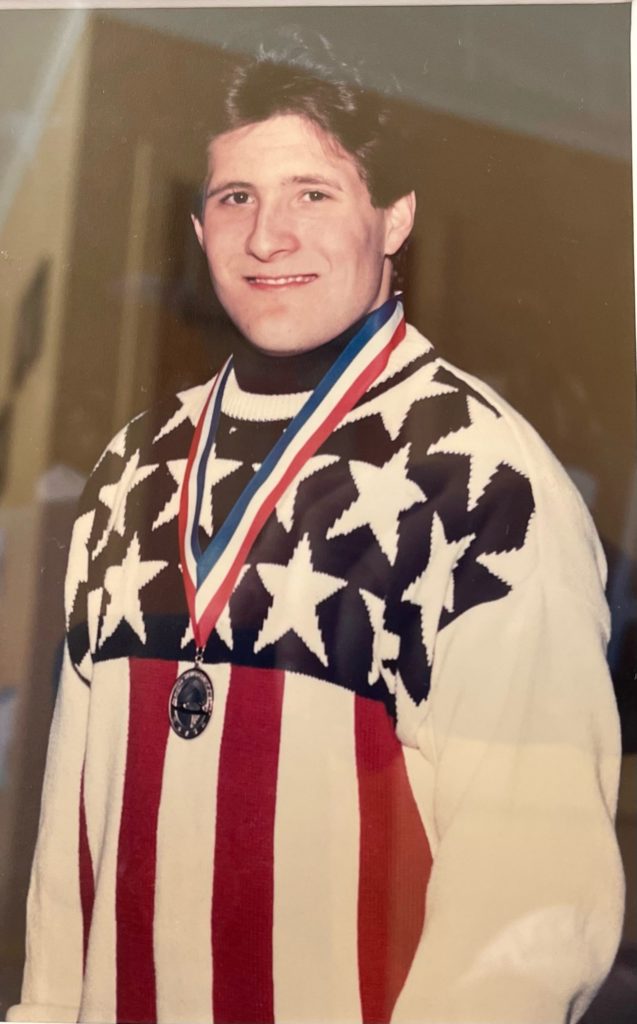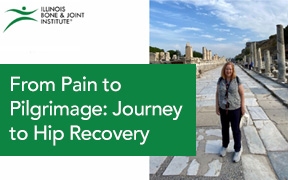
As a young man, Anthony was a four-time medalist figure skater. Now a skating instructor, he's glad to be ice skating after hip replacement surgery.
A former professional figure skater, Anthony was a four-time national medalist who started skating at age 6. His dad wanted him to be a well-rounded athlete and wished for him to play hockey. Instead, coaches quickly recognized Anthony’s gift and grace for figure skating.
Fast-forward to today, it’s no wonder Anthony needed to get back to ice skating after hip surgery. He has spent a lifetime on the ice.
“As a child, I started group lessons and after a couple of them, the instructor came up to my mom and asked what her plans were for my skating career,” Anthony recalls. “I started private lessons after that when I was 8, and I was competing and practicing six days a week. My career took off from there.”
Returning to ice skating after hip replacement surgery was the “icing” on Anthony’s cake, but he actually had three orthopedic issues solved at IBJI. Read on to learn more about the surgery that saved his career.
Ice Skating After Hip Replacement Surgery
Ice skaters and gymnasts are famous for pushing through pain, and Anthony was no different. Even though he is now 49, younger than the average age for a joint replacement patient, Anthony probably would have liked to have gotten back to ice skating after hip replacement surgery at an even younger age. He was experiencing a lot of pain but was glad to be able to return to his job. No one expected his recovery to be so fast.
“When you’re an athlete, you don’t have the luxury of taking time off of your sport,” Anthony says. “You learn to train through the pain.”
Ice Skating After Hip Replacement Surgery: Injuries Along the Way
As an adult, Anthony transitioned from figure skater to skating instructor. All the years on the ice resulted in his body parts wearing out, one by one. His hip wasn’t his only problem.
First, a shoulder injury sidelined his career, and then a knee injury. Ice skating after joint surgery was something that occurred later on, after he addressed the first two injuries at IBJI with the help of James R. Bresch, MD, a board-certified orthopedic surgeon with fellowship training in sports medicine.
“Dr. Bresch did such an amazing job with my shoulder, and when he looked at my knee, he said it sounded like a meniscus repair,” Anthony recalled.
He later found out that he had a bone-on-bone situation without much cartilage left in his knee, so Dr. Bresch recommended a partial knee replacement surgery. Anthony had been landing triples on his right knee, and he believes it wore out due to this repetitive action.
“That leg took all the pounding for all those years of figure skating,” Anthony says. “I decided to have surgery four years ago.”
Why Anthony Needed to Get Back to Ice Skating After Hip Surgery
Most recently, Anthony has been training hockey players and figure skaters in private lessons and group classes in Hoffman Estates, teaching hundreds of students. He never could see himself behind a desk, but his very physical job requires him to be on his feet, or skates, for most of the day. “When my right hip started bothering me, I knew something wasn’t right, but I skated on it for two or three months in pain.”
The Referral That Helped
Dr. Bresch does not perform hip surgeries, so he recommended Ritesh Shah, MD, an IBJI board-certified orthopedic surgeon who specializes in hip and knee disorders.
“I have had a long-term relationship with Dr. Bresch and felt great from both of his surgeries, so I trusted him,” Anthony says. “Dr. Shah came highly recommended and when I saw him, I was immediately put at comfort once we started getting into the diagnosis.”
Procedures Leading Up to Hip Replacement Surgery
Dr. Shah ordered an MRI with contrast and X-rays to diagnose Anthony’s labrum tear. That’s when he delivered the news to Anthony that he probably wouldn’t return to the ice for about six months.
“I knew that if I wasn’t on the ice, I wasn’t going to get paid,” Anthony said. “I was already doing the math in my head and saying that it wouldn’t work for me.”
Returning to the Ice After Hip Replacement
Dr. Shah looked at more imaging of Anthony’s hip and discovered arthritis. “He told me that I would probably need a hip replacement sooner than later and that I would be back on the ice in a couple of weeks,” Anthony recalls. “He recommended the hip replacement surgery, told me what was involved, put me at ease, and wanted to get me back on the ice as soon as possible. I said, ‘Sign me up.’”
Anthony Gets Back to Ice Skating After Hip Surgery in 2.5 Weeks
Anthony’s rehab was great, he says, and he worked with three therapists who, when they found out what he did for a living, were excited for him. “You could really see their enthusiasm and how dedicated they were to make sure I got back on the ice,” Anthony said. “They really pushed me because I said I was okay being pushed. I had massages and went up and down stairs, and they also tried to simulate the stride on the ice as much as possible.”
He estimates that his rehab went on for about six weeks, three days per week. But he was able to get back to ice skating after hip replacement surgery in just two and a half weeks.
“I was on skates and able to teach,” he recalls. “I didn’t do a full stride or demonstrate jumps or anything, but I was encouraged. It felt like it was my own hip, and each day, I got stronger and stronger.”
Four Months Later—Still Ice Skating
Anthony says his hip is “100 times stronger than it’s ever been.” He feels proud and happy to say that Dr. Shah fixed his problem.
“I would give Dr. Shah a 20 out of 10 for the fact that he is up-to-date on new procedures and rehab techniques that can get a younger person back to normal life as quickly as possible.”
No One Believes That He’s Ice Skating After Hip Surgery
Now that Anthony is working with students again, it’s as if he never had a procedure done. People who know him couldn’t tell the difference in his skating when he first came back to work. “They couldn’t believe that I was fresh off of surgery and that is 100 percent due to Dr. Shah.”
The Right Doctor, The Right Technology
High demand, athletic, and active patients require the most sophisticated total hip replacement surgery to return to their level of sport or function, says Dr. Shah.
“In my hands, this means a minimally invasive surgery using navigation technology to allow patients to walk minutes after surgery, climb stairs, and go home within two to three hours,” he says. “With activity-specific tailored physical therapy, patients can return to most activities at the same level or better. It has been my pleasure to treat so many patients like Anthony and help them return to their incredibly high level of activity rather safely and quickly. It is a joy that my team and I share – to see our patients get their high-functioning lives back.”
Get Relief From Your Hip Pain Today
Hip Care and Treatment at IBJI
Whether you are just starting your hip care journey or need a second opinion for your hip pain, IBJI’s hip surgeons are here to help provide you with the necessary care for your ailment. Get the relief you are seeking with the help of IBJI.
Schedule online with an IBJI hip surgeon to discuss treatment options like arthroscopic hip surgery and create an individualized approach to your care.
Check out IBJI’s additional online resources for hip care to learn more about conditions and read patient testimonials.
You Might Also Like ...
- 4 Tips for Finding a Great Hip Surgeon
- Common Causes of Hip Pain and When to Seek Treatment
- Hip Surgery Risks and Potential Complications
Last updated in April 2022.
*This content is for information only and is not intended to replace the diagnosis, treatment, or medical advice from your treating healthcare professionals. The content does not provide medical advice, does not constitute the practice of medicine or other healthcare professional services, and does not create a doctor-patient relationship. You should not rely on this information as a substitute, nor does it replace professional medical advice, diagnosis, or treatment. If you have concerns or questions, seek the advice of your healthcare professionals. If you think you may have a medical emergency, call your doctor or 911 immediately. Do not rely on electronic communications or communicate through this website for immediate, urgent medical needs. This website is not designed to facilitate medical emergencies. The use of the information is at the reader’s own risk. The links are provided for information and convenience only. We cannot accept responsibility for the sites linked or the information found here. A link does not imply an endorsement of a site.




